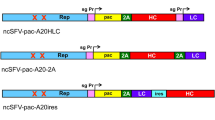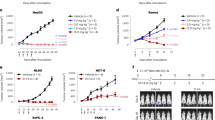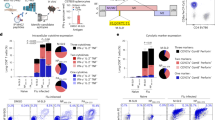Summary
The human CD30 receptor is highly overexpressed on the surface of Hodgkin Reed-Sternberg cells and has been shown to be an excellent target for selective immunotherapy using monoclonal antibody-based agents such as immunotoxins. To construct a new recombinant immunotoxin for possible clinical use in patients with Hodgkin’s lymphoma, we have chosen the murine anti-CD30 hybridoma Ki-4 to generate a high-affinity Ki-4 single-chain variable fragment (scFv). Hybridoma V-genes were polymerase chain reaction-amplified, assembled, cloned and expressed as a mini-library for display on filamentous phage. Functional Ki-4 scFv were obtained by selection of binding phage on the Hodgkin lymphoma-derived, CD30-expressing cell line L540Cy. The selected recombinant Ki-4 scFv was shown to specifically bind to an overlapping epitope on the CD30 antigen with binding kinetics similar to those of the original antibody. The Ki-4 scFv was subsequently fused to a deletion mutant of Pseudomonas exotoxin A (ETA’). The resulting immunotoxin Ki-4(scFv)-ETA’ specifically binds to CD30+ L540Cy cells and inhibits the protein synthesis by 50% at a concentration (IC50) of 43 pM. This recombinant immunotoxin is a promising candidate for further clinical evaluation in patients with Hodgkin’s lymphoma or other CD30+ malignancies.
Similar content being viewed by others
Article PDF
Change history
16 November 2011
This paper was modified 12 months after initial publication to switch to Creative Commons licence terms, as noted at publication
References
Adams, G. P., McCartney, J. E., Tai, M. S., Oppermann, H., Huston, J. S., Stafford, W. F., Bookman, M. A., Fand, I., Houston, L. L. & Weiner, L. M. (1993). Highly specific in vivo tumor targeting by monovalent and divalent forms of 741F8 anti-c-erbB-2 single-chain Fv. Cancer Res 53: 4026–4034.
Barth, S., Huhn, M., Wels, W., Diehl, V. & Engert, A. (1998). Construction and in vitro evaluation of RFT5(scFv)-ETA’, a new recombinant single-chain immunotoxin with specific cytotoxicity toward CD25+ Hodgkin-derived cell lines. Int J Mol Med 1: 249–256.
Bradbury, A., Ruberti, F., Werge, T., Amati, V., Di Luzio, A., Gonfloni, S., Hoogenboom, H. R., Piccioli, P., Biocca, S. & Cattaneo, A. (1995). The cloning of hybridoma V regions for their ectopic expression in intracellular and intercellular immunization. In Antibody Engineering, 2nd edn. Borrebaeck COxford University Press: New York 295 .
Dower, W. J., Miller, J. F. & Ragsdale, C. W. (1988). High efficiency transformation of E. coli by high voltage electroporation. Nucleic Acids Res 16: 6127–6145.
Dürkop, H., Latza, U., Hummel, M., Eitelbach, F., Seed, B. & Stein, H. (1992). Molecular cloning and expression of a new member of the nerve growth factor receptor family that is characteristic for Hodgkin’s disease. Cell 68: 421–427.
Engert, A., Burrows, F., Jung, W., Tazzari, P. L., Stein, H., Pfreundschuh, M., Diehl, V. & Thorpe, P. (1990). Evaluation of ricin A-chain containing immunotoxins directed against CD30 as potential reagents for the treatment of Hodgkin’s disease. Cancer Res 50: 84–88.
Engert, A., Gottstein, C., Bohlen, H., Winkler, U., Schön, G., Manske, O., Schnell, R., Diehl, V. & Thorpe, P. (1995). Cocktails of ricin A-chain immunotoxins against different antigens on Hodgkin and Sternberg-Reed cells have superior antitumor effects against H–RS cells in vitro and solid Hodgkin tumors in mice. Int J Cancer 63: 304–309.
Engert, A., Diehl, V., Schnell, R., Radzuhn, A., Hatwig, M. T., Drillich, S., Schön, G., Bohlen, H., Tesch, H., Hansmann, M. L., Barth, S., Schindler, J., Ghetie, V., Uhr, J. & Vitetta, E. S. (1997). A phase-I study of an anti-CD25 ricin A-chain immunotoxin (RFT5-SMPT-dgA) in patients with refractory Hodgkin’s lymphoma. Blood 89: 403–410.
Ghetie, M. A., Tucker, K., Richardson, J., Uhr, J. W. & Vitetta, E. S. (1992). The anti-tumor activity of an anti-CD22 immunotoxin in SCID mice with disseminated Daudi lymphoma is enhanced by either an anti-CD19 antibody or an anti-CD19 immunotoxin. Blood 80: 2315–2320.
Grossbard, M. L., Gribben, J. G., Freedman, A. S., Lambert, J. M., Kinsella, J., Rabinowe, S. N., Eliseo, L., Taylor, J. A., Blättler, W. A., Epstein, C. L. & Nadler, L. M. (1993). Adjuvant immunotoxin therapy with anti-B4-blocked ricin after autologous bone-marrow transplantation for patients with B-cell non Hodgkin’s lymphoma. Blood 81: 2263–2271.
Gruss, H. J. & Dower, S. K. (1995). The TNF ligand superfamily and its relevance for human disease. Cytokines Molec Ther 1: 75–105.
Hoogenboom, H. R., Griffiths, A. D., Johnson, K. S., Chiswell, D. J., Hudson, P. & Winter, G. (1991). Multi-subunit proteins on the surface of filamentous phage: methodologies for displaying antibody (Fab) heavy and light chains. Nucleic Acids Res 19: 4133–4137.
Horn-Lohrens, O., Tiemann, M., Lange, H., Kobarg, J., Hafner, M., Hansen, H., Sterry, W., Parwaresch, R. M. & Lemke, H. (1995). Shedding of the soluble form of CD30 from the Hodgkin-analogous cell line L540 is strongly inhibited by a new CD30-specific antibody (Ki-4). Int J Cancer 60: 539–544.
Klimka, A., Barth, S., Drillich, S., Wels, W., van Snick, J., Renauld, J. C., Tesch, H., Bohlen, H., Diehl, V. & Engert, A. (1996). A deletion mutant of Pseudomonas exotoxin-A fused to recombinant human interleukin-9 (rhIL-9-ETA’) shows specific cytotoxicity against IL-9-receptor-expressing cell lines. Cytokines Mol Ther 2: 139–146.
Kreitman, R. J. & Pastan, I. (1994). Recombinant toxins. Adv Pharmacol 28: 193–219.
Lorimer, I. A. J., Keppler-Hafkemeyer, A., Beers, R. A., Pegram, C. N., Bigner, D. D. & Pastan, I. (1996). Recombinant immunotoxins specific for a mutant epidermal growth factor receptor: targeted with a single chain antibody variable domain isolated by phage display. Proc Natl Acad Sci USA 93: 14815–14820.
Marks, J. D., Hoogenboom, H. R., Bonnert, T. P., McCafferty, J., Griffiths, A. D. & Winter, G. (1991). Bypassing immunization: human antibodies from V-gene libraries displayed on phage. J Mol Biol 222: 581–597.
Matthey, B., Engert, A., Klimka, A., Diehl, V. & Barth, S. (1999). A new series of pET-derived vectors for high efficiency expression of Pseudomonas Exotoxin-based fusion proteins. Genes, (submitted)
McCafferty, J., Fitzgerald, K. J., Earnshaw, J., Chiswell, D. J., Link, J., Smith, R. & Kenten, J. (1994). Selection and rapid purification of murine antibody fragments that bind a transition-state analog by phage display. Appl Biochem Biotechnol 47: 157–171.
Munro, S. & Pelham, H. R. (1986). An Hsp70-like protein in the ER: identity with the 78 kD glucose-regulated protein and immunoglobulin heavy chain binding protein. Cell 46: 291–300.
Pasqualucci, L., Flenghi, L., Terenzi, A., Bolognesi, A., Stirpe, F., Bigerna, B. & Falini, B. (1995). Immunotoxin therapy of hematological malignancies. Haematologica 80: 546–556.
Plaksin, D., Chacko, S., McPhie, P., Bax, A., Padlan, E. A. & Margulies, D. H. (1996). A T cell receptor Vα domain expressed in bacteria: does it dimerize in solution?. J Exp Med 184: 1251–1258.
Roovers, R. C., Henderikx, P., Helfrich, W., van der Linden, E., Reurs, A., de Bruine, A., Arends, J-W, de Leij, L. & Hoogenboom, H. R. (1998). High affinity recombinant phage antibodies to the pan-carcinoma marker epithelial glycoprotein-2 for tumour targeting. Br J Cancer 78: 1407–1416.
Sahin, U., Hartmann, F., Senter, P., Pohl, C., Engert, A., Diehl, V. & Pfreundschuh, M. (1990). Specific activation of the prodrug mitomycin phosphate by a bispecific anti-CD30/anti-alkaline phosphatase monoclonal antibody. Cancer Res 50: 6944–6948.
Schnell, R., Linnartz, C., Katouzi, A. A., Schön, G., Bohlen, H., Horn-Lohrens, O., Parwaresch, R. M., Lange, H., Diehl, V. & Lemke, H., Engert (1995). A development of new ricin A-chain immunotoxins with potent anti-tumor effects against human Hodgkin cells in vitro and disseminated Hodgkin tumors in SCID mice using high-affinity monoclonal antibodies directed against the CD30 antigen. Int J Cancer 63: 238–244.
Schwab, U., Stein, H., Gerdes, J., Lemke, H., Kirchner, H., Schaadt, M. & Diehl, V. (1982). Production of a monoclonal antibody specific for Hodgkin and Sternberg-Reed cells of Hodgkin’s disease and a subset of normal lymphoid cells. Nature 299: 65–67.
Terenzi, A., Bolognesi, A., Pasqualucci, L., Flenghi, L., Pileri, S., Stein, H., Kadin, M., Bigerna, B., Polito, L., Tazzari, P. L., Martelli, M. F., Stirpe, F. & Falini, B. (1996). Anti-CD30 (BerH2) immunotoxins containing the type-1 ribosome-inactivating proteins momordin and PAP-S (pokeweed antiviral protein from seeds) display powerful anti-tumor activity against CD30+ tumour cells in vitro and in SCID mice. Brit J Haematol 92: 872–879.
Vitetta, E., Thorpe, P. E. & Uhr, J. W. (1993). Immunotoxins: magic bullets or misguided missiles? Immunol Today 14: 252–259.
Wels, W., Harwerth, I. M., Müller, M., Groner, B. & Hynes, N. E. (1992). Selective inhibition of tumor cell growth by a recombinant single-chain antibody-toxin specific for the. erb, B-2 receptor. Cancer Res 52: 6310–6317.
Wiley, S. R., Goodwin, R. G. & Smith, C. A. (1996). Reverse signaling via CD30 ligand. J Immunol 157: 3635–3639.
Author information
Authors and Affiliations
Additional information
A Klimka and S Barth contributed equally to the work.
Rights and permissions
From twelve months after its original publication, this work is licensed under the Creative Commons Attribution-NonCommercial-Share Alike 3.0 Unported License. To view a copy of this license, visit http://creativecommons.org/licenses/by-nc-sa/3.0/
About this article
Cite this article
Klimka, A., Barth, S., Matthey, B. et al. An anti-CD30 single-chain Fv selected by phage display and fused to Pseudomonas exotoxin A (Ki-4(scFv)-ETA’) is a potent immunotoxin against a Hodgkin-derived cell line. Br J Cancer 80, 1214–1222 (1999). https://doi.org/10.1038/sj.bjc.6690488
Received:
Revised:
Accepted:
Published:
Issue Date:
DOI: https://doi.org/10.1038/sj.bjc.6690488



